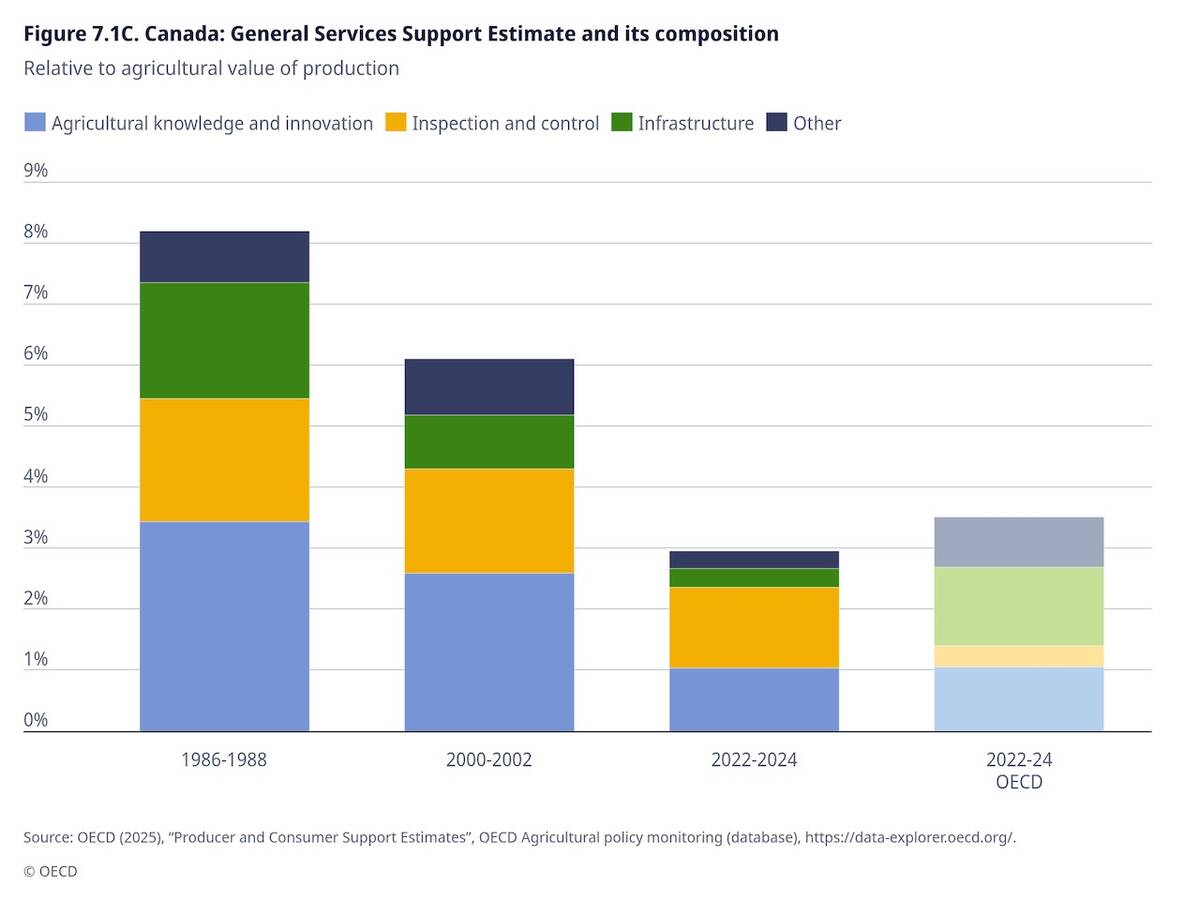First there was winterkill, then frost damage and finally lab tests confirmed what Colleen Edmunds of Grunthal Berries feared — the majority of her strawberry field was dead.
Edmunds was ready to retire, and this was the final straw.
“Why keep doing it?” she said.
They finished out the raspberry picking season and pulled the plug.
It’s not a farm’s sob story, according to her — she was going to retire anyway. Instead, she said, it’s a clear illustration of the lack of risk management supports for fruit farmers in Manitoba and a general lack of provincial work toward climate adaptation.
Read Also

OECD lauds Canada’s low farm subsidies, except supply management
The Organization for Economic Co-operation and Development says Canada’s farm subsidies are among the lowest, but still criticized supply management industries like dairy, poultry and eggs.
Why it matters: Berry producers say lack of business risk management supports left them in a lurch this year when Mother Nature entered the ring with a vengeance.
Unlike most crops grown in Manitoba, strawberries and other fruits can’t be insured against regular crop loss. Strawberries can be insured against hail and wildlife damage, and strawberries and saskatoons can be insured against losses while they’re being established.
The Prairie Fruit Growers Association (PFGA) has been asking the Manitoba Agricultural Services Corporation (MASC) for a crop loss or acreage loss insurance program for years, according to executive director Angie Cormier.
“We are progressing,” Cormier said. “When I look back to where we were five years ago when Darren (her husband) and I came into this role, we’ve definitely made progress… but it’s slow.”
What insurance exists comes from successful PFGA lobbying, for instance.
The difficulty is finding a program that can work for multiple fruit crops, each with its own issues and different valuations per acre.
It is their hope that other provinces, which already have fruit insurance programs, might provide templates for an eventual Manitoba program. British Columbia, for instance, insures berry crops against hail, frost, excessive moisture and drought, according to that province’s website. Strawberry plants can also be insured for their first two winters while tree fruits like cherries and apples have their own insurance program. Nova Scotia also insures blueberries, strawberries, raspberries and tree fruits.
MASC isn’t stonewalling fruit producers, said David Van Deynze, MASC’s chief client officer.
“It’s not that there’s an unwillingness,” he said. “It’s just we maybe need to be a little bit more creative.”
It’s been difficult to get consensus on what an effective program looks like, he added.

“That becomes even more problematic for us because there’s not a huge number of berry growers and not a huge number of acres, so if we develop a program that only 20 per cent of the people want, man, we’re down to insuring two or three people,” Van Deynze said.
Cormier acknowledged that the industry doesn’t have a lot of growers. At the same time, she argued, fruit carries a high value per acre.
However, it may be hard to find a program that works for everyone, she agreed.
AgriStability may be an option for berry farmers, Edmunds said — though she wasn’t aware of it until recently. Ideally farms would have a suite of programs at their disposal.
“A grain farm can have AgriStability but also crop insurance,” Edmunds said. “There’s other types of insurance that other farmers benefit from that we don’t.”
Season of loss
This year, berry farmers could have used the help.
They’ve just come through a season of what Cormier describes as likely some of the worst losses in the last decade.
Late this spring, the Co-operator reported some farms had suffered winterkill due to lack of snow, while others were set back by a late-spring frost.
By early July, media outlets like CBC, Global News and the Winnipeg Free Press were also running stories on the tough season and decreased yields on Manitoba berry farms.
The trouble started in winter, Edmunds said. January and February saw spates of temperatures above zero, which allowed snow to melt and trickle down among the plants. When -30 C or -40 C days resumed, the moisture froze and suffocated the plants, Edmunds said. Ice crystals may have also damaged the plant tops.
It’s not the high temperatures or the low, but the fluctuations between them that likely caused the winterkill, said Edmunds.
Farmers can only expect more volatility due to climate change, she argued, and added that government policy, such as more serious attention on water retention projects to hold water back on land, ought to prepare for it.
“Everyone just thinks, ‘Oh my goodness,’ we’ve got a flood. Oh my goodness, we’ve got a drought.’ And that’s all they say,” Edmunds said.
The province is in the midst of updating its water management strategy, which will likely include policy toward more efficient water use, according to preliminary reports recently released.
Food policy needed?
“Having ability to be able to manage and experience those extremes but also not have farm failure is of critical importance,” said Ian Mauro, executive director of the Prairie Climate Centre.
“This summer is showing us that in spades,” he added.
The top levels of science have indicated that food and water security may be some of the most dramatic changes to prepare for in coming years, said Mauro, adding that policy interventions are needed so farmers can stay viable.
A tighter relationship between farmers and ‘eaters’ can cause more awareness and therefore greater public support for policy that helps farm families, he added.
A local food strategy and more food production and processing near home may also be key to planning ahead for climate volatility, Mauro said.
More precise farming methods may also offset some risks.
For MASC, weather volatility hasn’t necessarily caused a huge upswing in crop insurance payouts for conventional field crops, Van Deynze said. Last year was quite dry, yet cereal and canola yields were average to above average.
Farmers, meanwhile, are incredibly precise with equipment and fertilization and that reduces risks, he argued.
“We are finding that science and farming practices are helping to offset those impacts,” he said.
Based on the last decade of data, “It’s not obvious to us that we should be more concerned about risk from a weather perspective,” Van Deynze said.
















